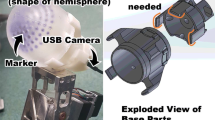Abstract
In general, it is difficult to present tactile information because arbitrary curvatures of the curved surface and many degrees of freedom need to be realised. On the other hand, psychophysical studies have suggested that human visual and tactile sensations have an illusory fusion characteristic. This means that we can recognise curved surfaces of objects through visual and tactile sensations, even if exact tactile information is not presented. Hence, by utilising the human characteristic of sensory fusion, realisation of a curved surface display can be simplified. From such motivation, the human fusion characteristics of visual and tactile sensation are measured, and are quantitatively analysed. Based on the analysed results, a curved surface display for three fingers is developed. In the curved surface display, only four curved patterns are utilised instead of presenting many curved patterns. Performance of the developed tactile display is proved through evaluated experiments.
Similar content being viewed by others
References
Künnapas TM. An analysis of the vertical-horizontal illusion. Journal of Experimental Psychology 1995; 49: 134–140
Maheux M, Townsend C, Gresock CJ. Geometrical factors in illusion of direction. American Journal of Psychology 1960; 73:535–543
Bartley SH. The perception of size or distance based on tactile and kinesthetic data. Journal of Psychology 1953; 36:401–408
Coren S, Girgus JS. Visual spatial illusion: many explanations Science 1973; 179–5034
Gillam B. Geometrical illusions. Scientific American 1980; 242(1): 86–95
Brigell M, Uhlarik J. The relational determination of length illusions and length after effects. Perception 1979; 1.8: 187–197
Wu Jing-Long, Morita S, Kawamura S. Human sensory fusion on visual and tactile sensing for virtual reality. IEEE International Conference on Robotics and Automation 1996; 2: 2365–2370
Wu Jing-Long, Nakahata M, Kawamuras et al. Measurement of binocular stereoacuity for design of head mounted display with wide view. IEEE International Conference on Systems, Man and Cybernetics 1996; 2: 929–934
Wu Jing-Long, Nakahata M, Kawamuras. A new head mounted display system with adjustable disparity for high depth-performance. IEEE International Conference on Systems, Man and Cybernetics 1995; 1: 298–303.
Kawamura S, Ida M, Wada T et al. Development of a virtual sports machine using a wire drive system — A trial of virtual tennis. IEEE International Conference on Intelligent Robots and Systems 1995; 1:111–116
Author information
Authors and Affiliations
Rights and permissions
About this article
Cite this article
Wu, J.L., Kawamura, S. A curved surface display for three fingers based on human visual and tactile sensory fusion. Virtual Reality 3, 102–111 (1998). https://doi.org/10.1007/BF01417671
Issue Date:
DOI: https://doi.org/10.1007/BF01417671




